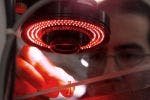Machine vision systems are programmed to perform defined tasks such as counting objects on a conveyor, reading serial numbers, or searching for surface defects. Though machine vision systems have neither the intelligence nor the learning capability of human inspectors, they are considered useful in many applications. Machine vision systems are favored for visual inspections that require high-speed, high-magnification, 24-hour operation, and repeatability of measurements.
Why and how are LEDs used?
One of the most crucial aspects in machine vision is the selection of the correct lighting. For many years, fibre-optic lighting combined with a halogen light source provided the best solution. However, LEDs have evolved and their price/performance attributes have improved, leading to even more reliable and more consistent performance in machine vision applications.
There a number of techniques used to light the subject, and they all require the LEDs to be arranged in various ways. These include:
- Ringlights for mounting around the camera lens to provide even, shadow-free front illumination.
- Backlights that provide even illumination from behind to show up features such as edge defects.
- Lightlines, which provide an intense uniform line of light, such as required in line-scan camera applications.
- Dark-field ringlights, which emit the light at a shallow angle, and are useful when looking for defects such as scratches.
- Coaxial lighting which only allows the directly reflected light to enter the camera; this is good for shiny surfaces etc.
Advantages over other light sources
In the past, the most popular approach was to use a halogen light source combined with fibre-optic light delivery to position the light as necessary. Major disadvantages are the need to replace the bulb every 1500 hours and the rapid degradation in light intensity. The lifetime of a red LED is typically 100,000 hours, and as they are the most popular colour they are the least expensive. Red LEDs are also the best for monochrome machine vision applications, since they correspond with the peak sensitivity of the camera’s CCD sensor.
In applications which require larger back lights and light lines, it is very hard to get enough light down the fibre. When using LEDs you can simply use more LEDs and make sure you remove the heat efficiently.
The initial cost for a stable light source and fibre optic attachment is roughly the same as an equivalent LED array. Therefore, in terms of cost/hour, LEDs are far less expensive than anything else that provides equivalent stable lighting. With the use of a suitable controller, LEDs are very easy to strobe, increasing the life and output intensity. There is also no restriction on cable length.
Some specific product examples
Future developments
Improvements in white LED technology would provide the greatest benefit to machine vision applications. If the lifetime and colour consistency could be improved they would completely remove the need for halogen sources.
Although today’s LEDs are bright enough for most applications, brighter LEDs would be useful for lightlines and larger scale applications. More efficient LEDs would also bring great benefits, including a reduction in the need to remove dissipated heat.










